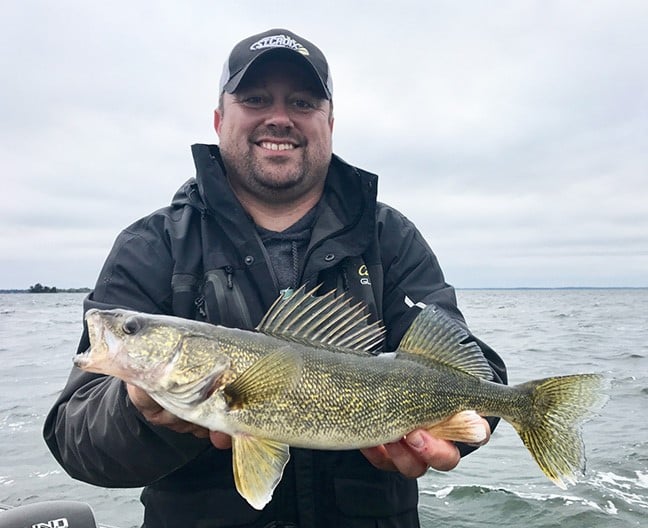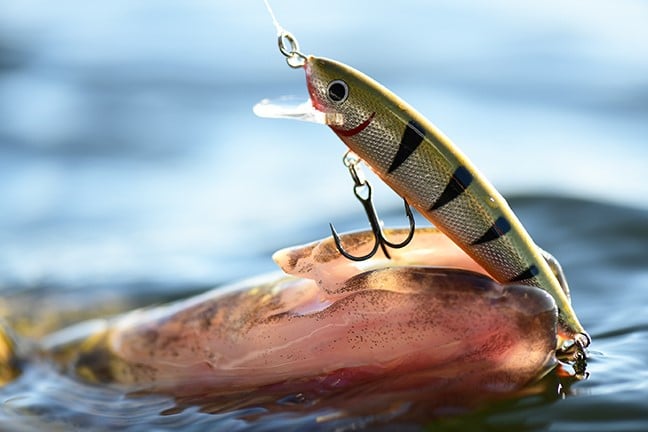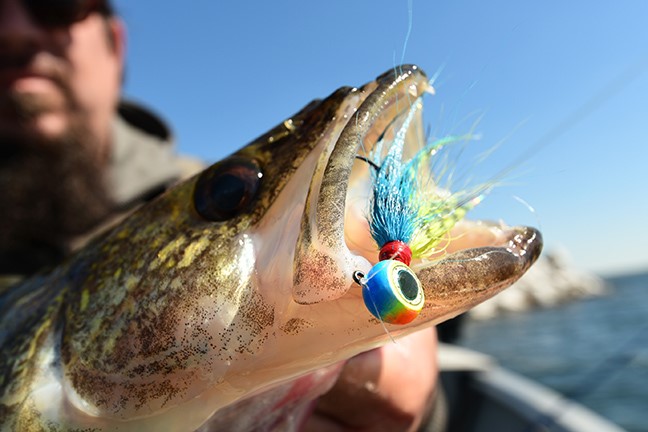
Expert walleye angler Joel Nelson simplifies river walleye fishing techniques to capitalize on the spring bite.
As early as February and certainly by March and April, there are ample river-fishing opportunities across the U.S., even where most of the lakes are completely frozen. Many fisheries remain open year-round, but the spring spawn and 10 lb walleyes can get anyone fired up to fish, making the spring months a favorite nationwide.
That doesn’t mean it’s an easy game, as chasing down river walleyes is akin to firing at moving targets. First, you’ve got a spawn that’s dictated by mother nature and doesn’t always progress like clockwork. Prolonged cold spells or warm rains can slow down or speed up the step-wise approach of the spawn. That’s without taking into account the big thaw. Some seasons see heavy snowpack that melts all at once, causing flooding throughout backwaters areas and really scattering fish among stumps and root-wads. Peak flows are affected dramatically, and savvy anglers are glued to the hydrographs posted by NOAA and predictions from the National Weather Service.
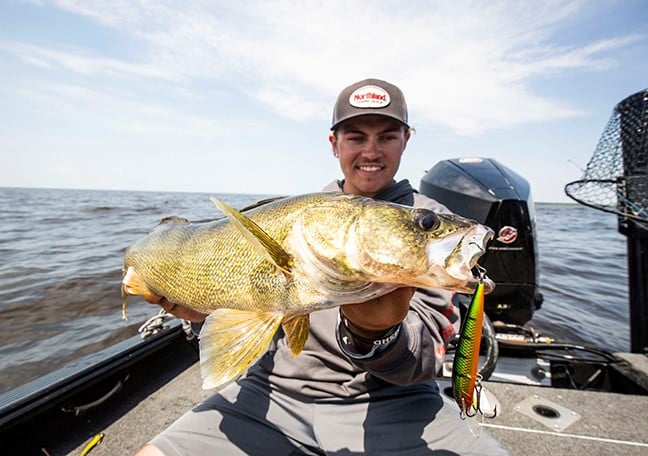
It’s a dynamic game, and for that reason, I’ve always been a fan of tackling the river in chunks of days, rather than an afternoon here, or a morning there over the same time period. You want to be there for the change, or so much of what you do out there just starts to feel random and disjointed. You may bump into fish here or there, without really knowing the “why,” making it hard to put together a pattern that holds. Those days turn into “motor days” where you start at one end of the river and go up or down, hitting spot after spot just looking for something good. It’s not a bad way to survey the scene and hit fish coming and going, but even two days in a row more often leaves you patting your back rather than scratching your head.
Even then, early-season days on the river can mean some struggle time, so it’s good to come prepared. I’ll never forget river rat and walleye-guy wisdom from the likes of Dean Marshall who at one time ran Evert’s Resort near Hager City, WI, and Pool 4 of the Mississippi. I always knew it’d be tough when Dean was scooping minnows for customers rather than selling plastics, saying, “You might need some of these guys today.” Having some meat in the boat was a good fallback when pitching jigs and pulling cranks wasn’t working well, but so was the simple act of fishing spots thoroughly. When bites fell short, often the fish were still there but needed some more enticement and slower roll.
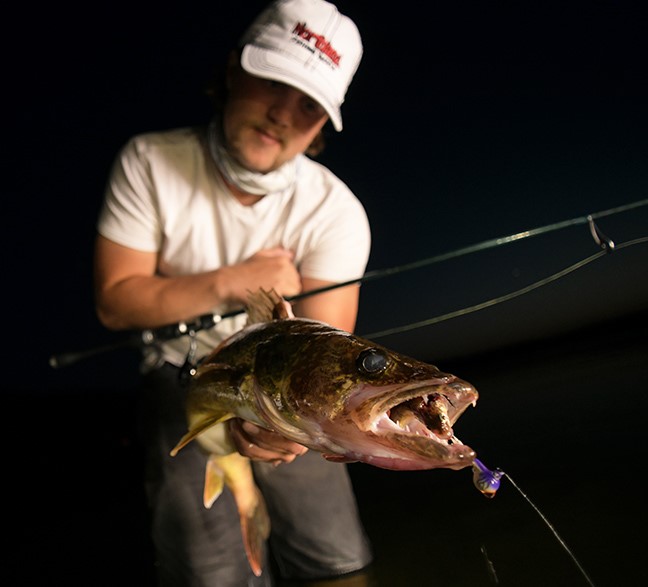
Vertical Play
Truly, on rivers like the Mississippi and Missouri, and many more, jigs have always been the main game for catching walleyes. If jigs are the event, then the Northland Tackle Fire-Ball jig could be a star player, catching more walleyes below dams, spillways, and current seams than any other before them. On those tough spring days, it’s great to rig any old minnow threaded through the mouth with a hook out the back. Jig vertically as the river washes you downstream, either under a controlled slip with bow-mount down or under power of the river itself. Use heavy weights to stay down, ½ oz and greater, as the fish will be on sand ridges, current breaks, or other structures immediately near the bottom, so you need to be too. Control your drift based on that vertical presentation, keeping the jig straight up and down at all times, adjusting trolling motor speed to keep it there. If fish are short-striking, perhaps the best part of the Fire-Ball jig is that you can choose several lengths of stinger hook harnesses to clip directly to the jig (it has an extra “eye” at the jig’s base) and bury that extra treble as a surprise for unsuspecting sauger and walleye. That goes for the whole lineup of Fireball Jigs and Metallic Fire-Balls being good additions to the tacklebox for the same presentation.
The walleye fishing technique has been so dominant for so many years, St. Croix makes a rod specifically for it. The Eyecon Heavy Metal ECS58HF is short (5’8”) by design. Keeping that jig vertical requires control, and nearer your center hence the short length. The magic is in the power and action, though. With heavy jigs being the norm, you need a heavy action to stand up to jigs approaching a full ounce, yet a fast action is required to directly push hooks through hard mouths. Pool cues offer little feel and translate to spit hooks, while your average walleye rod lacks the level of carbon fiber sensitivity the Heavy Metal does, while still being able to fight sloppy tip syndrome.
Pitch to Win
By far and away the best bites of the spring walleye fishing comes pitching jigs and plastics to shallow sand and current breaks where big females are preparing to dump eggs and later feed. There are many times each spring when pitching jigs is akin to bass fishing for walleyes. You contend with cover, are forced to make an accurate cast, and vicious reaction strikes follow. Yet, you need to work jigs like the Northland Metallic Eyeball or Deep Vee Bucktail Jig with some method. Have a few choices and weights rigged up and ready, both on mono/fluoro and braid, as current affects those line types differently. Simple trial and error determine which days, or more appropriately which currents, require mono/fluoro vs. braid. Rig ribbon-tailed plastics, or any variety of shad-style soft plastic baits in a few select colors. Natural variations and earthy colors produce, but so do chartreuse and other bright colors with some sun. Consider, too, pre-rigged options like the Northland Mimic Minnow Limber Leech that is ready to fish out of the box and come in many of those same color combinations.
You shouldn’t be surprised that this technique requires a totally different fishing rod. No longer are you vertical, so getting some length approaching seven feet is a good goal. The actions change, too, as jig weights are dramatically lighter. 1/8 oz, 3/16 oz, and ¼ oz are all good selections depending on depth and current, putting you in the medium-light to medium rod power category. Next, and most importantly, choose a rod with an extra-fast action. For jigs, it’s a godsend and WILL make you a better angler. The whole idea is a forgiving tip section that flings far, feels well, and converts quickly to heavy backbone when deflected. I grew up fishing St. Croix Premiers, Avids, and Legend Extremes, each getting faster and more sensitive with each release. Today, many of those same rods are still the pinnacle of jig-fishing tech, with the Avid AVS69MLXF and Legend Elite ES610MXF being personal favorites. For bleeding-edge feel and the kind of rod that can mentally map the bottom for you, the new Legend Xtreme XFS610MLXF is literally without parallel.
Crank It Up
Many times, after pitching to shallow walleye without success, you’ll pull off the break, stare down at the graph and see fish everywhere. They’re stacked up, often males with some post-spawn females mixed in depending on your timing. It’s a perfect time to pull some crankbaits on them, especially upstream. You’ll need a 3-way rig, often with several ounces of weight to keep crankbaits like the 3/16 oz Northland Rumble Shiner or 3/8 oz Rumble Shad near the bottom. A few feet of fluorocarbon leader goes back to the bait, and a short 3”-18” dropper is required for the weight depending on the diving depth of the crankbait. Choose a lighter line on the dropper, as lead is cheaper than crankbaits, with your mainline being a braid. Pull these baits just slightly faster than the current, focusing heavily on your electronics to literally pull up the side of these fish facing upstream into the current, dancing that crankbait tantalizingly in their faces until they’re forced to eat. The range of colors on the Northland Rumble Series crankbaits is impressive for a river guy, as much of the custom crankbait painting schemes that for years dominated the tournament scene can be found in these baits.
Pull them on baitcasting equipment, with rods that are up to the task from a heft perspective, but also have a great feel to discern fouling from fish. To me, there are only two I’d consider, with the telescoping Eyecon Trolling ET76MMT being fun to fish and easy to stow. With lower flows and less weight, along with even more feel, I’d choose the Legend Tournament Walleye Series Bounce ‘N Troll LWC70MHM. Both are perfect for other techniques like pulling spinners and long-lining those same Rumble Shads along breaklines, so you’ve got a pretty versatile setup. Line-counter options on baitcasting reels are pretty handy, if not for this bite, for others mentioned above. It’s nice to recreate the magic just by memorizing the right number that keeps getting you a bite.
Whether if you are fishing a jig or crankbaits, springtime means hitting the river for some walleyes. If you’ve never tackled the river, it can be a beast without question, but also makes you a better angler for the rest of your season. Mastering boat control on a conveyor belt of springtime flow, while precisely placing jigs and positioning the boat to continually hit that current seam, really makes dealing with wind and other challenges less of an issue throughout the year. Not to mention the 10 lb eyes that fill up these legendary systems and beyond.
Story by Joel Nelson
